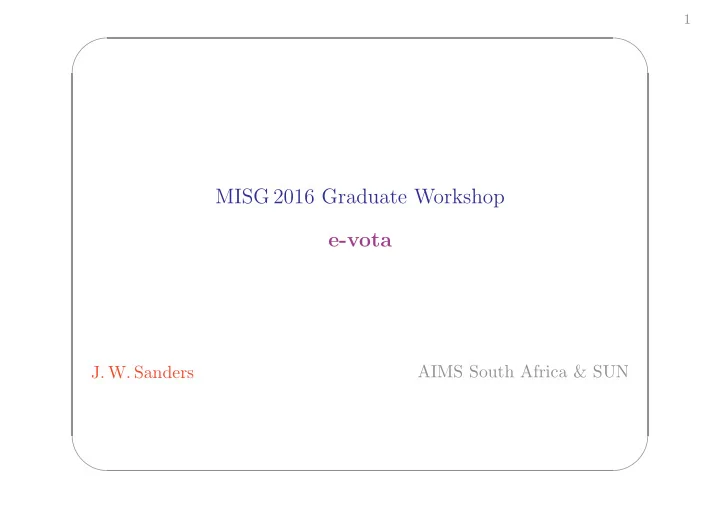

✬ ✩ 1 MISG 2016 Graduate Workshop e-vota AIMS South Africa & SUN J. W. Sanders ✫ ✪
2 The problem Election by vote: from clubs to nations. Many voting protocols are in common use and their features are well known (and perhaps surprising at first). However all voting systems share important properties, including: • voter authentication • confidentiality of vote • accountability of result. Can we design a distributed voting system?
3 Characteristics of this problem What characterises a typical MISG problem? How this problem is similar; and different. What is required: a design ; its correctness and efficiency. What is not required: a program ; testing it in various cases. The maths is pure , discrete and perhaps unfamiliar. Abstraction. Design space. Nondeterminism.
4 Specification Assume the voting protocol is given by a ‘black box’ procedure. Concentrate on the rest of the system. Our system is specified by its functionality (reflects the voting protocol) extra features (authentication, confidentiality, anonymity, + security?, + robustness?)
5 Design techniques • Describing a distributed design. Modularity. Information flow by shared variables or message passing. • Reasoning about distributed behaviour. Each module must be autonomous. Invariant properties. • Public key encryption. Secure communication. Digital signatures. • Mathematical notation. Z formalism.
6 Example: the voting protocol Voters Candidates := perms ( Candidates ) Rankings Votes := Voters → Rankings VProtocol := Votes → Rankings
7 Concerns 1. Modelling: how to abstract (what is ‘observable’?). 2. Does the distributed e-format offer new possibilities for a voting system? 3. Correctness? 4. Efficiency?
8 References • Survey on electronic voting schemes , Laure Fouard, Mathilde Duclos and Pascal Lafourcade. 65 pages. • Design and analysis of a practical e-voting protocol , Mari´ an Novotn´ y. 14 pages. • Analysis of an Electronic Voting System , Tadayoshi Kohno, Adam Stubblefield, Aviel Rubin and Dan Wallach. 23 pages.
Recommend
More recommend